The following article was originally published here on the Signal Integrity Journal‘s website.
February 11 | Patrick Hindle
DesignCon highlighted the latest in high-speed digital design with keynotes covering the hot topics in the industry such as quantum computing, 5G, and artificial intelligence. DesignCon offers training boot camps covering various core topics essential to the skills toolbox of hardware design engineers. This year’s boot camps covered the following topics:
- Power Integrity Hands-On Simulation & Measurement
- The Art of Signal Integrity Analysis
- Machine Learning & Artificial Intelligence for Hardware & Electronics Design
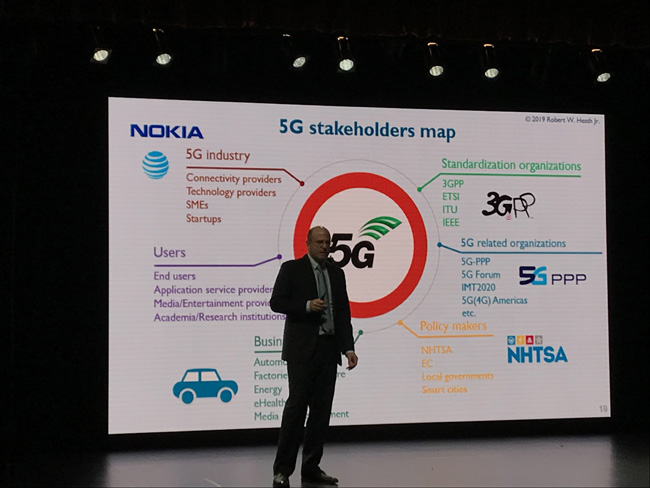 I was able to attend the keynote given by Prof. Robert Heath from the Department of Electrical & Computer Engineering at the University of Texas at Austin. He discussed their work in 5G for Vehicle-to-anything (V2X) Communications noting that automated driving will require Gbps data rates and msec latency which mature 5G should achieve using mmWave technology. While mmWave beams are subject to blocking, he is looking at sub 6 GHz aided beam training and machine learning to determine which beams to use. He also had some innovative ideas the project is testing such as using basestation transmission direct to cars to guide them where to go – maybe we could do away with street lights in the future.
I was able to attend the keynote given by Prof. Robert Heath from the Department of Electrical & Computer Engineering at the University of Texas at Austin. He discussed their work in 5G for Vehicle-to-anything (V2X) Communications noting that automated driving will require Gbps data rates and msec latency which mature 5G should achieve using mmWave technology. While mmWave beams are subject to blocking, he is looking at sub 6 GHz aided beam training and machine learning to determine which beams to use. He also had some innovative ideas the project is testing such as using basestation transmission direct to cars to guide them where to go – maybe we could do away with street lights in the future.
SIJ spent most of the time in the exhibition giving away our T-shirts, raffling off a SI/PI book library and meeting with attendees and exhibitors. Here is an overview of what some of the exhibitors were highlighting at the event:
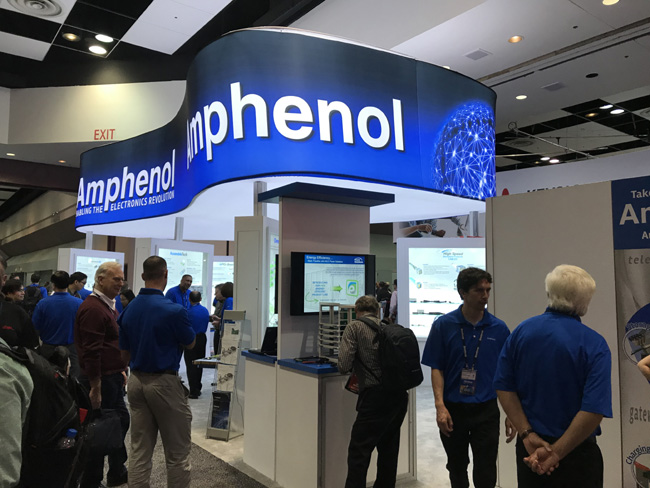 Amphenol RF expanded its SMP product line – a high-frequency, subminiature board-to-board solution – to include several new bullet adapters and a straight cable plug. This connector series is designed for blind mate applications with a variety of board spacing and package size requirements. The additional SMP bullet adapters feature a straight plug to plug (with female, socket contacts) in-series configuration and are available in lengths of 6.45, 6.96, 9.90, 13.16, 14.5 and 22.4 mm. These 50 ohm bullets are constructed with gold plated beryllium copper and are designed to compensate of both radial and axial misalignment. The SMP series operates at DC to 26.5 GHz making this product family ideal for applications that require a high data rate transmission, such as broadband, instrumentation and telecommunications applications.
Amphenol RF expanded its SMP product line – a high-frequency, subminiature board-to-board solution – to include several new bullet adapters and a straight cable plug. This connector series is designed for blind mate applications with a variety of board spacing and package size requirements. The additional SMP bullet adapters feature a straight plug to plug (with female, socket contacts) in-series configuration and are available in lengths of 6.45, 6.96, 9.90, 13.16, 14.5 and 22.4 mm. These 50 ohm bullets are constructed with gold plated beryllium copper and are designed to compensate of both radial and axial misalignment. The SMP series operates at DC to 26.5 GHz making this product family ideal for applications that require a high data rate transmission, such as broadband, instrumentation and telecommunications applications.
Amphenol Ardent was featuring their LinkOVER termination in Amphenol’s OverPass™ series of PCB trace bypass connectors. LinkOVER is ideal for 56G and 112G systems. Also their TR Multicoax Equal Trace which delivers superior signal integrity from multiple high speed channels in an arc footprint, making it ideal for applications where equal and short trace lengths are imperative for performance tuning. And finally, they featured their TR Auto which offers superior signal integrity in the narrow E-Band (71-86+ GHz) making it ideal to replace cumbersome waveguide connectors in automotive radar applications.
Amphenol SV Microwave was featuring their complete line of high frequency coaxial/surface mount PCB connectors that meet the industry need for high performing, highly reliable solderless connectors for precision thin substrate mounting. The standard solderless PCB compression mount connectors can create undesirable results on thin (< .010”) dielectric PCB. SV’s LiteTouch PCB connector addresses this issue by maintaining a solderless connection while keeping the board material intact. Current configurations include 2.92 mm, 2.4 mm, and SMA versions. They were also featuring their new Mini-D RF Connection System has industry leading .110” port-to-port spacing and uses removable SMPS bullets for high mating cycle applications without damaging the housing. SV’s low profile edge and surface mount PCB connector options are available with excellent RF performance through 67 GHz.
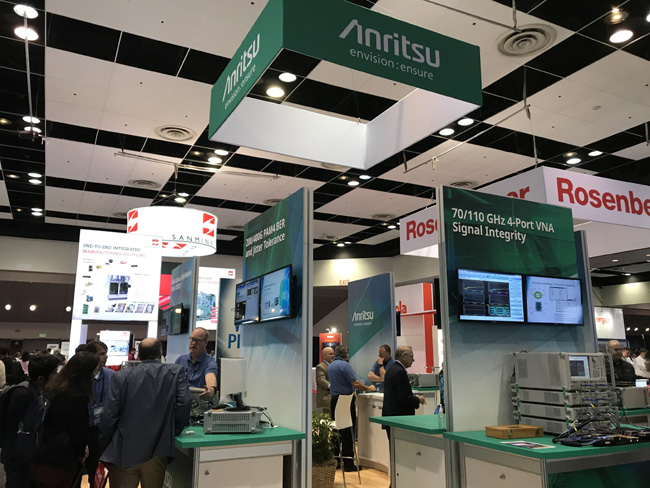 Anritsu demonstrated test solutions and techniques to verify high-speed communications including PCIe 3.0/4.0/5.0 and Ethernet PAM4. They had demonstrations on PCIe 4.0 RX Link Equalization (LEQ) tests using the Anritsu Signal Quality Analyzer-R MP1900A BERT with a real-time oscilloscope and the Synopsys® DesignWare® Controller and PHY IP for PCI Express as the device under test (DUT). The demonstration showed a detailed procedure of how to conduct and troubleshoot the RX LEQ compliance test. In addition to LEQ tests, jitter tolerance tests on a PCIe 4.0 DUT will be conducted.
Anritsu demonstrated test solutions and techniques to verify high-speed communications including PCIe 3.0/4.0/5.0 and Ethernet PAM4. They had demonstrations on PCIe 4.0 RX Link Equalization (LEQ) tests using the Anritsu Signal Quality Analyzer-R MP1900A BERT with a real-time oscilloscope and the Synopsys® DesignWare® Controller and PHY IP for PCI Express as the device under test (DUT). The demonstration showed a detailed procedure of how to conduct and troubleshoot the RX LEQ compliance test. In addition to LEQ tests, jitter tolerance tests on a PCIe 4.0 DUT will be conducted.
Anritsu also had a test station integrating the MP1900A and BERTWave™ MP2110A all-in-one test set with a TE Connectivity quad small form factor double density (QSFP-DD) high-speed connector and cable assembly conducting PAM4 TX and RX tests. The demonstration highlighted the performance of the TE Connectivity solution while also showcasing Anritsu’s ability to conduct highly accurate and repeatable tests on 400GbE components and systems.
 ANSYS 2019.1 delivers simulation solutions to support the important global engineering trends of autonomy, 5G connectivity and electrification. With higher operating frequencies, components being placed closer together and the endless drive to add more features, the effects of the electromagnetic fields on the circuit, surrounding components and systems needs careful consideration. With the release of 2019.1, ANSYS continues to advance their industry leading electronics design platform to address these design challenges with valuable new features including EMI mitigation and electromigration analyses for PCB and electronic packaging applications, advanced multiphysics capability of closed loop electromagnetic-thermal coupling. The new release allows our customers to design and optimize designs and identify potential compliance issues ensuring that products will be designed right the first time. See videos demonstrations in our video library.
ANSYS 2019.1 delivers simulation solutions to support the important global engineering trends of autonomy, 5G connectivity and electrification. With higher operating frequencies, components being placed closer together and the endless drive to add more features, the effects of the electromagnetic fields on the circuit, surrounding components and systems needs careful consideration. With the release of 2019.1, ANSYS continues to advance their industry leading electronics design platform to address these design challenges with valuable new features including EMI mitigation and electromigration analyses for PCB and electronic packaging applications, advanced multiphysics capability of closed loop electromagnetic-thermal coupling. The new release allows our customers to design and optimize designs and identify potential compliance issues ensuring that products will be designed right the first time. See videos demonstrations in our video library.
ARC Technologies was highlighting their dielectric absorber honeycomb material that is constructed with hexagonal cells. It can be tuned to operate at various frequencies over a broad spectrum. The electrical performance can be maximized for insertion/transmission or reflection loss. Honeycomb absorbers are fabricated from a range of materials including phenolic, high-temperature aramid and fiberglass. Their proprietary lossy formulation and loading technique can tailor honeycomb to offer maximized performance from low to high frequencies. With the construction, configuration and cell structure it offers outstanding reflection, insertion / transmission loss. It can achieve 30-40 dB of shielding to 40 GHz. A unique feature is that air can flow through it to provide cooling to the electronics while maintain shielding around them.
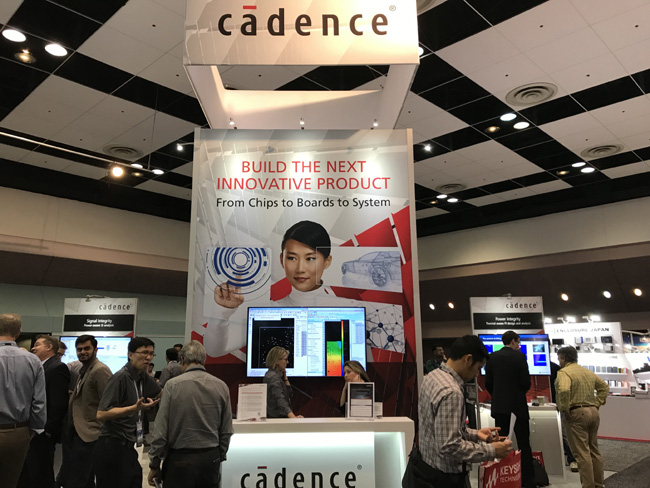 Cadence featured Sigrity™ their signal integrity and power integrity (SI/PI) tools, multi-gigabit SerDes analysis, advanced DDR IP and design/analysis tools, automated IBIS-AMI model creation, integrated electronics/photonic design automation, and advanced IC packaging and cross-platform solutions. They had demos highlighting:
Cadence featured Sigrity™ their signal integrity and power integrity (SI/PI) tools, multi-gigabit SerDes analysis, advanced DDR IP and design/analysis tools, automated IBIS-AMI model creation, integrated electronics/photonic design automation, and advanced IC packaging and cross-platform solutions. They had demos highlighting:
- Thermal-aware PI design and analysis including multi-level tree topology set-up from PCB schematics
- Power-aware SI analysis of next-generation GDDR and LPDDR interfaces using IBIS-AMI models
- Streamlining multi-gigabit SI and 3D interconnect extraction across PCB-connector interfaces for TX-to-RX interface compliance
- Advanced packaging and cross-platform solutions for next-generation 2.5D and 3D-IC design
- 112G long-reach SerDes for next-generation datacenter applications
![]() eSilicon was in the Samtec booth presenting their collaboration with Wild River Technology and Samtec to develop an advanced test system that addresses the incredible signal integrity demands of 56/112G PAM4 operation. The test system design utilizes the upcoming IEEE P370 standard in association with compliance metrics 802.3bs, OIF CEI – 56G PAM4, and COBO to validate the required performance. Keysight’s Advanced Design System was used to explore power spectral density, examining how much bandwidth is needed for effective testing and what specific metrics of IEEE P370 are most important, such as return loss, equivalent return loss, time-domain reflectometry (TDR) and impedance analysis. eSilicon’s 56G PAM4 & NRZ DSP-based 7 nm SerDes was used to drive the communication channels. The design employed a channel-modeling platform to improve de-embedding quality out past 70 GHz, establishing clear targets of equalization and creating an advanced reference design suited for immediate 3D electromagnetic design. The core of the design was Samtec’s Bulls Eye® Test Point System. Three independent teams worked on the design. See our blog post here for more details.
eSilicon was in the Samtec booth presenting their collaboration with Wild River Technology and Samtec to develop an advanced test system that addresses the incredible signal integrity demands of 56/112G PAM4 operation. The test system design utilizes the upcoming IEEE P370 standard in association with compliance metrics 802.3bs, OIF CEI – 56G PAM4, and COBO to validate the required performance. Keysight’s Advanced Design System was used to explore power spectral density, examining how much bandwidth is needed for effective testing and what specific metrics of IEEE P370 are most important, such as return loss, equivalent return loss, time-domain reflectometry (TDR) and impedance analysis. eSilicon’s 56G PAM4 & NRZ DSP-based 7 nm SerDes was used to drive the communication channels. The design employed a channel-modeling platform to improve de-embedding quality out past 70 GHz, establishing clear targets of equalization and creating an advanced reference design suited for immediate 3D electromagnetic design. The core of the design was Samtec’s Bulls Eye® Test Point System. Three independent teams worked on the design. See our blog post here for more details.
Epson Timing Devices was featuring their G-Series TCXOs that provide stability to support all the latest networking standards and requirements operating from 10-50 MHz. In addition to < +/- 100 ppb temperature stability, the devices achieve the industry’s leading wander, short-term stability, environmental isolation and airflow isolation plus comply with the latest networking standards from 3GPP and IEEE-1588 to ITU-T packet clock drafts and recommendations. They also featured their ultra low jitter E-Series SPXOs with 50 fs @ 156.25 MHz. Their frequency range is 25-200 MHz with tight stability.
HUBER+SUHNER showcased their SUCOFLEX® 550S that has a long-service life, offering durable and reliable electrical performance and designed to withstand dust, abrasion, pressure and moisture. Available to use in numerous applications from bench-top testing to high throughput RF production testing, the SUCOFLEX 550S is versatile, flexible and adaptable. They also showed their consistent over temperature (CT) cable assemblies for applications which require precise electrical length connectivity in fluctuating temperatures. With industry-leading phase vs. temperature performance, the company’s latest CT assemblies meet all of the stringent requirements not only in Test and Measurement applications, but also in Aerospace, Defense, and Industrial environments. They also featured their MXPM multicoax testing solutions offering best-in-class signal integrity, magnetic locking mechanism, automatic interface protection and a cost-efficient PCB socket.
 ITEQ Corporation recently introduced its new IT-8338A and IT-8350A products for use in Antenna and LNB applications. IT-8338A, with a nominal dielectric constant of 3.38 +/-0.04 and a dissipation factor of 0.0038@ 10 GHz, is a product intended for LNB and antenna applications. IT-8350A, with a nominal dielectric constant of 3.50 +/- 0.04 and a dissipation factor of 0.004 @ 10 GHz, is the next generation product for Antenna applications. The products are based on thermoset systems with Tg of 185 ℃ and Td higher than 360 ℃. The main advantage of these products over incumbent products is that these are FR4 products that deliver the best cost/performance ratio on the market. The products offer excellent dimensional stability as a result of their thermoset make up. IT-8338A and IT-8350A offer very stable DK/Df with temperature and humidity: TCDK is ~35 ppm/℃. The IT-8338A and IT-8350A products are not prone to oxidation and issues related to thermal aging that are common with the incumbent products.
ITEQ Corporation recently introduced its new IT-8338A and IT-8350A products for use in Antenna and LNB applications. IT-8338A, with a nominal dielectric constant of 3.38 +/-0.04 and a dissipation factor of 0.0038@ 10 GHz, is a product intended for LNB and antenna applications. IT-8350A, with a nominal dielectric constant of 3.50 +/- 0.04 and a dissipation factor of 0.004 @ 10 GHz, is the next generation product for Antenna applications. The products are based on thermoset systems with Tg of 185 ℃ and Td higher than 360 ℃. The main advantage of these products over incumbent products is that these are FR4 products that deliver the best cost/performance ratio on the market. The products offer excellent dimensional stability as a result of their thermoset make up. IT-8338A and IT-8350A offer very stable DK/Df with temperature and humidity: TCDK is ~35 ppm/℃. The IT-8338A and IT-8350A products are not prone to oxidation and issues related to thermal aging that are common with the incumbent products.
Insulated Wire has developed Re-Flex™ to provide improved electrical and mechanical performance over traditional hand-formable designs. Available in 0.085”, 0.141” and 0.235” diameters (identified as RF085, RF141 and RF250), IW’s RF cable series offers the advantages of the same lamination process used on our Low Loss products. Combined with the same double shield construction plus a solder-free tin/alloy plated outer braid, the Re-Flex™ design provides a re-formable cable that will not develop micro-fractures with repeated flexing, eliminating manufacturability issues associated with conformable style RG cables.
Introspect Technology specializes in low data rate signal integrity as well as higher data rate smaller-sized instruments used by field engineers and production engineers. At DesignCon, the team was showing their MIPI products as well as a new test and characterization solution for fifth generation double-data-rate (DDR5) memory interface applications. The product is based on the company’s SV5C Personalized SerDes Tester, a protocol-parallel BERT solution. The new DDR5 product is comprised of software and hardware extensions to the SV5C featuring single ended signaling at data rates beyond the JEDEC specification for DDR5, per-channel skew control and matching with picosecond resolution and accuracy, per-channel jitter injection, and protocol-based traffic generation and automated training.
 Keysight Technologies announced the new Infiniium UXR-Series of oscilloscopes, with models ranging from 13 to 110 GHz of true analog bandwidth, offering industry leading signal integrity, and investment protection that meets the needs of technology advancements today and tomorrow. The new Infiniium UXR-Series enables high-speed serial and optical designers, focused on current and next generation technologies, to quickly create comprehensive designs with higher margins, thereby reducing time to market of their innovation. Some features include: 10-bit vertical resolution and industry leading signal integrity for superior effective number of bits (ENOB); sampling rates of 256 GSa/s per channel on 40 to 110 GHz models and 128 GSa/s per channel on 13 to 33 GHz models; up to four full-bandwidth channels with less than 35 fs (rms) of inter-channel intrinsic jitter providing accurate timing and skew measurements; optional full factory grade self-calibration module which ensures ongoing measurement accuracy while reducing the need to take the unit out of service.
Keysight Technologies announced the new Infiniium UXR-Series of oscilloscopes, with models ranging from 13 to 110 GHz of true analog bandwidth, offering industry leading signal integrity, and investment protection that meets the needs of technology advancements today and tomorrow. The new Infiniium UXR-Series enables high-speed serial and optical designers, focused on current and next generation technologies, to quickly create comprehensive designs with higher margins, thereby reducing time to market of their innovation. Some features include: 10-bit vertical resolution and industry leading signal integrity for superior effective number of bits (ENOB); sampling rates of 256 GSa/s per channel on 40 to 110 GHz models and 128 GSa/s per channel on 13 to 33 GHz models; up to four full-bandwidth channels with less than 35 fs (rms) of inter-channel intrinsic jitter providing accurate timing and skew measurements; optional full factory grade self-calibration module which ensures ongoing measurement accuracy while reducing the need to take the unit out of service.
Keysight Technologies introduced the first comprehensive DDR 5.0 test solution. Keysight’s total solution approach to DDR5 testing includes a new receiver, transmitter, and protocol test solutions. The new receiver and transmitter test solution also includes high performance M8040A 64 Gbaud High-performance BERT and Infiniium UXR-Series Real-Time Oscilloscope hardware with the lowest noise and jitter floor to allow the most accurate measurement with highest margins. They also announced PathWave Memory Designer, a new double data rate (DDR) memory simulation capability that is part of PathWave Advanced Design System (ADS) 2019. The new capability makes it easy for developers to compare simulated data with actual measured results, reducing the time required to complete product development workflows. PathWave ADS Memory Designer connects simulation and test workflows, addressing common DDR memory design challenges with new workflows that automate routine tasks and harness data analytics to gain faster actionable insight into simulation data.
Keysight announced KeysightCare, a new service model that offers design and test engineers dedicated, proactive support for instruments, software, and solutions. KeysightCare offers unparalleled access to a range of resources such as technical experts, training materials, productivity tools, knowledge centers, and success managers, to speed customer innovation, and accelerate product time-to-market. KeysightCare provides:
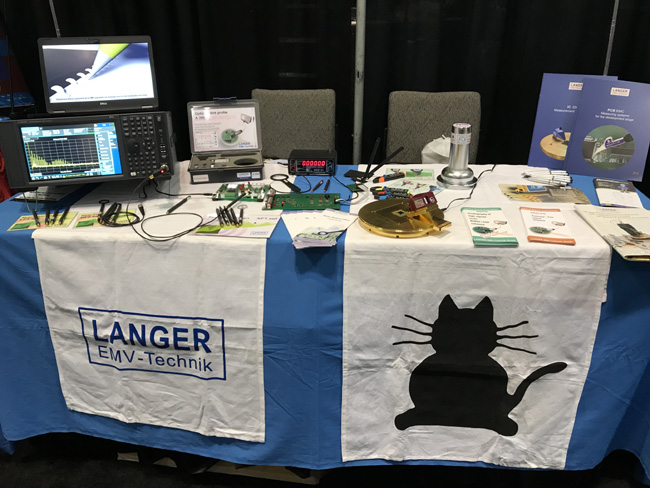 LANGER EMV featured the ICI HH500-15 L-EFT pulse magnetic field source that couples fast transient pulses into a test IC (open die). This allows for side channel analysis or testing the immunity of individual areas of the IC. The pulse injection into the open die can be used for pulse immunity analysis and side channel analysis. The pulse rise time is 2 ns and resolution is 500 um. Also available are the pulse electric field and pulse current sources.
LANGER EMV featured the ICI HH500-15 L-EFT pulse magnetic field source that couples fast transient pulses into a test IC (open die). This allows for side channel analysis or testing the immunity of individual areas of the IC. The pulse injection into the open die can be used for pulse immunity analysis and side channel analysis. The pulse rise time is 2 ns and resolution is 500 um. Also available are the pulse electric field and pulse current sources.
LEONI’s industry-leading high-speed cable technology enables superior high-speed interconnects up to 400 Gbit/s for data center applications. They were featuring QSFP-DD cables supporting 400 G (8 x 50 G) with breakout versions: QSFP-DD to 8 x SFP56, QSFP-DD to 2 x QSFP56 and QSFP-DD to OSFP. They also were featuring their OSFP cable supporting 400 G with the same features as the QSFP-DD.
Marki Microwave specializes in broadband, microwave frequency baluns and balun transformers for test and measurement and high speed analog to digital interface applications among other components. Using proprietary design and fabrication techniques, Marki creates the highest performance baluns in the world. Their baluns Feature:
- Extremely low amplitude and phase balance
- Flat Group Delay
- Typical >25 dB Common Mode Rejection
- 1:1 and 1:2 Impedance Ratios Available
- Multi-Octave bandwidths to 67 GHz
- Small form factor SMT packages
Mentor was presenting many technical sessions in their booth. Three that they highlighted were “Accelerating The Design cycle: Model-Free Analysis” that described a model-free analysis flow that lets designers run simulations to make design tradeoffs and assess impact on design margins even when detailed device models aren’t available. The presentation took a closer look at the types of decisions system designers make and their dependence on silicon-accurate simulation models. A second was “Ensuring DDRx Reliability: Power-Aware Simulation” that covered how interactions between a system’s Power Delivery Network (PDN) and high speed signals are unwanted, unavoidable and only serve to reduce the design’s voltage and timing margins. Power-Aware Simulation lets designers assess different mitigation strategies to determine their impact on design margins and determine the most cost-effective solution. The third was “Reducing Certification Risks: Automating Design Compliance Testing” covering how the methods used to assess compliance are complex and increase the risk that products fail certification testing, requiring modifications that increase the product’s time to market and require yet another round of certification testing. Their HyperLynx DRC assesses safety compliance using the specific measurement methods associated with different standards and design applications, identifying failure areas quickly and accurately.
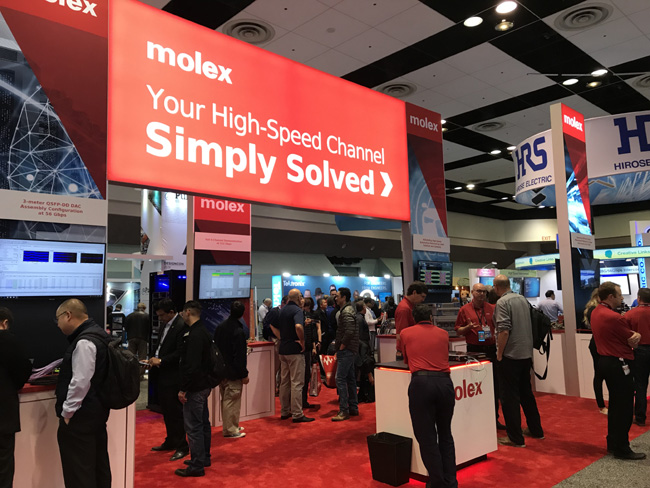 Molex showed off their collaboration with Ixia, a Keysight Business, in a joint demonstration that showed Ixia’s AresONE 8x400GE test system generating a combined 3.2 Tbps live Ethernet traffic over Molex QSFP-DD passive copper direct attach cable (DAC) assemblies at up to 3 meters to the device under test. Cisco’s N3432D-S 32-port 400 Gpbs Ethernet switch was used in the demonstration. Real-time analysis on AresONE featured test results of pre-FEC per lane BER of around 1E-9. The performance of the inherent BER of the cable provides ample margin for the KP4 FEC to correct these errors, resulting in zero Frame Loss Ratio. The impressive operation of a 400 Gbps Ethernet DAC over a 3-meter cable demonstrates that the companies’ innovative solutions fulfill industry standard IEEE specs.
Molex showed off their collaboration with Ixia, a Keysight Business, in a joint demonstration that showed Ixia’s AresONE 8x400GE test system generating a combined 3.2 Tbps live Ethernet traffic over Molex QSFP-DD passive copper direct attach cable (DAC) assemblies at up to 3 meters to the device under test. Cisco’s N3432D-S 32-port 400 Gpbs Ethernet switch was used in the demonstration. Real-time analysis on AresONE featured test results of pre-FEC per lane BER of around 1E-9. The performance of the inherent BER of the cable provides ample margin for the KP4 FEC to correct these errors, resulting in zero Frame Loss Ratio. The impressive operation of a 400 Gbps Ethernet DAC over a 3-meter cable demonstrates that the companies’ innovative solutions fulfill industry standard IEEE specs.
Radiall’s D-Lightsys brand offers a new family of products which support very short reach Free-Space Optical communications (FSO). This solution is well suitable for board-to-board, box to box or portable equipment communication. The design is compatible with misalignment tolerances above what electrical connectors typically offer. The F-Light family of Free-Space Optical transceivers (FSO) are specially designed for board-to-board, box to box applications where large misalignment and/or vibrations are critical. F-light transmitters and receivers allow operating misalignment between two boards or boxes and are are around +/-1 mm and +/-1°. The devices feature a small footprint (8×8 mm) and are compatible with a bit rate from 100 Mbps up to 5 Gbps (a 10 Gbps version – coming soon). Devices operate in the extended [-40; +90°C] temperature range and consume less than 100 mW each.
Remcom provides electromagnetic simulation and site-specific radio propagation software for analyzing complex EM problems and antenna propagation. Their family of products includes: XFdtd which is full wave 3D electromagnetic simulation software for modeling and analyzing EM field simulation. Wireless InSite is site-specific radio propagation software for analyzing wireless communication systems (includes Wireless Insite MIMO for ray tracing that simulates the multipath of large numbers of MIMO channels). And XGtd is electromagnetic simulation software for far field radiation, RCS, and EMC/EMI for electrically large platform.
Roger Corp featured their XtremeSpeed RO1200 circuit materials that are engineered to meet the electrical and thermal/mechanical requirements of high speed designs. RO1200 circuit materials enable system designers the flexibility to design leading edge systems that maximize data throughput and minimize latency in performance demanding applications. With a low dielectric constant of 3.05, and a max dissipation factor of 0.0017 @10 GHz, XtremeSpeed RO1200 laminates provide outstanding signal integrity, reduced signal skew, and reduced cross-talk. Combined with superior thermal/mechanical performance, low CTE, and a halogen free UL 94 V-0 rating, XtremeSpeed RO1200 materials are well suited for the most demanding high layer count applications.
 Rohde & Schwarz featured the VNAs with multiport architecture for measurements from 100 kHz to 40 GHz including the new R&S ZNBT40 which is the first vector network analyzer (VNA) with a broad frequency range from 100 kHz to 40 GHz and up to 24 integrated test ports. Developers can use it for applications such as measurements on 5G antenna arrays. The multiport architecture is not only advantageous for tests on multiport components, but also for simultaneous testing of multiple DUTs in production to boost throughput. Rohde & Schwarz ensures specified performance on up to 24 test ports with the R&S ZNBT40. Also new is the R&S ZNBT26 for measurements up to 26.5 GHz.
Rohde & Schwarz featured the VNAs with multiport architecture for measurements from 100 kHz to 40 GHz including the new R&S ZNBT40 which is the first vector network analyzer (VNA) with a broad frequency range from 100 kHz to 40 GHz and up to 24 integrated test ports. Developers can use it for applications such as measurements on 5G antenna arrays. The multiport architecture is not only advantageous for tests on multiport components, but also for simultaneous testing of multiple DUTs in production to boost throughput. Rohde & Schwarz ensures specified performance on up to 24 test ports with the R&S ZNBT40. Also new is the R&S ZNBT26 for measurements up to 26.5 GHz.
Just prior to DesignCon, R&S introduced the R&S ZNA high-end vector network analyzer, a powerful, universal test platform for characterizing active and passive components. The two models R&S ZNA26 (10 MHz to 26.5 GHz) and R&S ZNA43 (10 MHz to 43.5 GHz) offer an outstanding dynamic range of 146 dB (typical) and a trace noise as low as 0.001 dB at 1 kHz IF bandwidth. These two features are essential for measurements on high-rejection filters. It is also the first VNA that is fully touch screen operated with an intuitive display. The R&S ZNA offers a unique approach, focused on the device under test (DUT), to simplify measurement configuration. The user first selects the type of DUT (e.g., a mixer or amplifier) and is then guided step-by-step through the configuration to the desired test setup. See some of the R&S demos in our video section here.
Sierra Circuits has a free downloadable guide explains everything a PCB designer needs to know about HDI design techniques. The Free HDI Design Guide explains how to use HDI PCB design techniques to achieve board layouts for an optimum balance of cost and performance and guides the selection of materials best suited for your application The advantages of the HDI PCB manufacturing include; architectures can reduce PCB layer count and footprint, better protect signal integrity than alternative through-hole approaches, and can result in improved manufacturing yield and board reliability. The Sierra Circuits’ HDI design planning tool kit is available here.
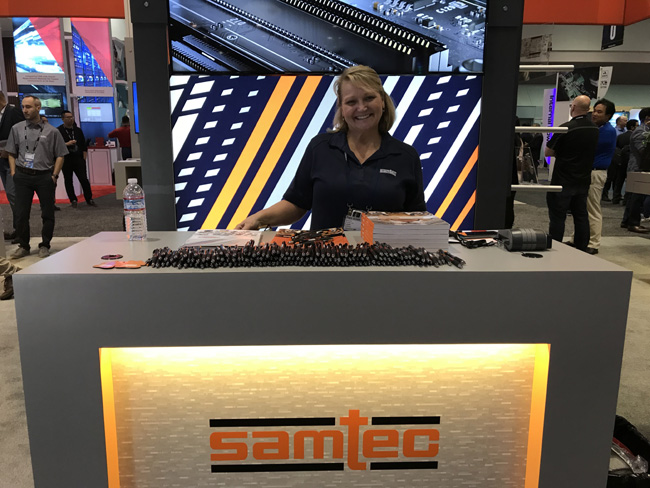 Samtec showcased their latest high-performance interconnect and technologies including high-speed technologies for Silicon-to-Silicon optimization with new high-speed, high-bandwidth optical, board-to-board and cable-to-board interconnects plus 56 Gbps PAM4 and 112 Gbps PAM4 product demonstrations. Featured products in their booth included:
Samtec showcased their latest high-performance interconnect and technologies including high-speed technologies for Silicon-to-Silicon optimization with new high-speed, high-bandwidth optical, board-to-board and cable-to-board interconnects plus 56 Gbps PAM4 and 112 Gbps PAM4 product demonstrations. Featured products in their booth included:
- NovaRay™: The innovative design of NovaRay combines extreme density and extreme performance for 112 Gbps PAM4 per channel, in 40% less space than traditional arrays, for an industry leading 4.0 Tbps aggregate data rate.
- Samtec Flyover™: As bandwidth requirements rapidly increase, routing signals through lossy PCBs, vias and other components has become one of the most complex challenges designers face. Samtec Flyover breaks the constraints of traditional substrate signaling and hardware offerings, resulting in a cost-effective, high-performance answer to the challenges of 112 Gbps bandwidth and beyond.
- FQSFP-DD: Samtec was the first interconnect company to bring the QSFP Flyover product line to market. Samtec is excited to announce another first in the Flyover realm: Samtec’s FQSFP-DD is the first product to take the Samtec Flyover architecture concept to the QSFP-DD form factor.
- AcceleRate®: Samtec’s AcceleRate® cable assembly is the slimmest in the industry with a 7.6 mm body width ideal for closer proximity to the IC. The high-density 2-row design features 8 and 16 pair configurations on a 0.635 mm pitch for up to 92 pairs per square inch.
TE Connectivity has leveraged its signal integrity expertise to deliver one of the highest-performing 56 Gbps QSFP56 and SFP56 cable assembly portfolios in the market. The new portfolio of products supports aggregate data rates of 100 and 200 Gbps, making them ideal for a range of applications including data center equipment, test and measurement equipment and wireless infrastructure devices.
TE’s new QSFP56 and SFP56 high speed cable assemblies comply with Ethernet 802.3cd and support 56G PAM-4 applications. The cable assemblies’ optimized construction minimizes insertion loss and cross talk, and the solutions are backward compatible with existing QSFP and SFP connectors and cages for easy upgrades. Paired with TE’s QSFP28 and SFP28 connectors and cages, the 56 Gbps QSFP56 and SFP56 cable assemblies offer a broad solution for connectivity between devices.
 Teledyne LeCroy announced support for PCI Express 5.0 physical layer testing with an advantage in calibration and test completion time, expanding on what is already an extensive set of PCI Express test solutions. Demand for higher throughput in storage devices and data centers requires data-transfer rates higher than PCIe 4.0’s 16 GT/s. Therefore, PCIe 5.0, at 32 GT/s, is expected to see rapid adoption. Teledyne LeCroy extended its physical-layer test domain to enable that adoption. The new Teledyne LeCroy QPHY-PCIE5-TX-RX physical-layer software option for LabMaster 10Zi-A series oscilloscopes provides:
Teledyne LeCroy announced support for PCI Express 5.0 physical layer testing with an advantage in calibration and test completion time, expanding on what is already an extensive set of PCI Express test solutions. Demand for higher throughput in storage devices and data centers requires data-transfer rates higher than PCIe 4.0’s 16 GT/s. Therefore, PCIe 5.0, at 32 GT/s, is expected to see rapid adoption. Teledyne LeCroy extended its physical-layer test domain to enable that adoption. The new Teledyne LeCroy QPHY-PCIE5-TX-RX physical-layer software option for LabMaster 10Zi-A series oscilloscopes provides:
- Automated receiver-test calibration for jitter-tolerance testing at the full 32 GT/s PCIe 5.0 rate. While existing solutions can take up to a full day to calibrate before even starting the test, the Teledyne LeCroy calibration will be completed in a fraction of that time.
- Automated collection of waveforms and testing of PCIe 5.0 transmitter parameters to significantly speed and simplify test throughput.
- Support for characterization of PCIe signals in both common-clocked and independently-clocked (SRIS/SRNS) architectures, linking Teledyne LeCroy’s SDAIII-CompleteLinQ jitter-decomposition, eye-diagram, and noise-analysis software with new capabilities for faster PCIe 5.0 debug.
Wireless Telecom Group’s Noisecom worked with SIJ editor Eric Bogatin to develop a quick and simple way to masure the system bdwidth of a scope-pobe system using a Noisecom NC1100 wide-band noise source with frequency components extending from 1 MHz to > 10 GHz. They measured this signal at the input to the Teledyne LeCroy WavePro HD 804 using the highest bandwidth connection they could find, calculate its FFT to get the spectrum, and use this as the stimulus. Then we insert the cables and probes and measure the changed response. This is typically a difficult and involved process but using wideband noise makes it easy. Read their article on SIJ describing the method.